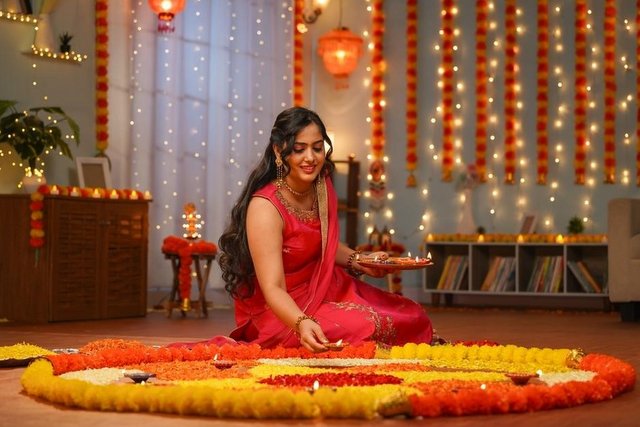
[ad_1]
Diwali, also known as the Festival of Lights, is one of the most widely celebrated festivals in India. However, as we know, India is a land of many (1.4 billion to be exact). Within this vast expanse, Diwali takes on a myriad of colours, customs, and traditions.

So, if you’re as curious as we are to find out how this glorious festival is celebrated around the country, design some breathtaking Diwali cards and join us as we embark on a journey to explore the kaleidoscopic beauty of Diwali across the diverse landscapes of India.
Diwali Celebrations In Northern India
In Northern India, Diwali is celebrated with some seriously unparalleled enthusiasm and grandeur. It celebrates the return of Lord Rama after defeating Ravana, the asura king. It symbolises the victory of light over darkness. Homes are elaborately adorned with rangoli designs, and clay lamps (diyas) light up every nook and corner. It’s a time for families to come together and perform the Lakshmi Puja — seeking the blessings of the goddess of wealth and prosperity. This is also a time for the unceasing use of firecrackers, believed to be used to drive away evil spirits and a particular favourite of children.
But it doesn’t just end at home — many of the shops are kept open until the afternoon, believing that a successful sale on Diwali day will ensure a prosperous year ahead. Public streets are lit up and decked in the day’s colours, creating a magical atmosphere. The vibrant bazaars are a hive of activity as people shop for new clothes, the day’s traditional sweets and ornate decorations.
Sikhism
Diwali is celebrated in Sikhism as well. Apart from Diwali, they also celebrate it as Bandi Chhor Divas. This translates to ‘Prisoner Release Day’, and it’s marked by Sikhas as a commemoration of the release of Guru Hargobind Ji along with 52 other prisoners from Gwalior Fort in the early 17th century. This story stands as an important lesson in the teachings of righteousness over tyranny.
There is a huge focus on light in the Sikh communities of Punjab, especially in the focal points of gurudwaras. Sikhs congregate to worship in buildings that are spectacularly illuminated. There, communal feasts will be prepared, and the Akhand Path will take place. This is a continuous reading of the teachings of Guru Granth Sahib, which tends to start a few days before the festival and concludes on the day. Processions called Nagar Kirtan may also take place, with Sikh communities singing hymns and sharing prayers as they move through the streets.
Diwali Celebrations In Southern India
Did you know that most southern Indians refer to Diwali as “Deepavali”? Unlike in the North, Diwali in the South commemorates the conquering of the Asura Naraka, a powerful king of Assam, who imprisoned tens of thousands of inhabitants. Diwali in the south is celebrated in the Tamil month of aippasi (thula month) ‘naraka chaturdashi’ thithi, preceding amavasai.
It’s an early start to the Diwali celebrations for the South Indians. They clean their houses from top to bottom, decorate them with kolam (rangoli) patterns, and prepare to welcome guests. On the morning of Diwali, the oldest member of the house applies sesame oil to the heads of all the family members, after which it’s off for a bath — the youngest member first. They emerge with new clothes and the prospect of a day’s worth of firecrackers, symbolic of the killing of the demon king Narakasur.
Additionally, in many houses in the South, a grand feast awaits the family. Elaborately prepared and rich in taste, these dishes are a testament to the vast culinary treasure of the region. The families come together to share the dishes, strengthening the bonds of their kinship. Laughter and the happy sounds of celebration fill the air, creating an unforgettable atmosphere.
Diwali Celebrations In The East
Now, we’re off to the East. The Eastern regions of India observe a distinct tradition of celebrating Diwali with the worship of the Goddess Kali, the embodiment of the power of creation and destruction in the same entity. People offer their prayers to Kali, in the form of idols as well as clay lamps (diyas). These idols — elaborate and beautifully painted — form the centrepiece of the Diwali celebrations, decked with vibrant flowers and colourful decorative elements.
In the evening, families come together to perform the special puja rituals for the worship of Goddess Kali. They seek her blessings for strength, courage, and protection. The prayers are accompanied with the rhythmic strains of chants and the scent of incense, conjuring the sacred within homes. Devotees offer flowers, sweets, and other traditional items to the goddess, in a sign of gratitude.
In West Bengal and Odisha especially — the two states where Kali Puja is the most fervently celebrated — the worship of Kali doubles up as a cultural extravaganza. Elaborate processions, cultural events, and artistic performances unfold on the streets of these eastern states, as communities come together in a spirited celebration. The night is lit up by a million firecrackers that lend a dimension of sheer joy to the occasion. The flares of light and sound resonate with the energy of Goddess Kali’s triumph over evil, turning the piousness of worship into a colourful spectacle for everyone to enjoy.
Diwali Celebrations In The West
And finally, we step into the world of Diwali celebrations in the Western India. This region is mostly associated with business and trade, so there is (unsurprisingly) a lot of focus on prosperity and blessings. Days before the main Diwali event, the markets of Western India buzz with activity as enthusiastic shoppers prepare for the festival. The streets are lined with stalls offering an array of traditional attire, festive decorations, and an assortment of sweets and gifts.
In Gujarat, the approach to Diwali is marked by the creation of intricate and colourful rangolis. These artistic designs, often crafted at the entrance of homes, add a visual feast to the surroundings. They are also believed to invite positive energy and good fortune. On the main day of Diwali, as in the Northern regions, families perform Lakshmi Puja. Shops remain open because good sales on the day foretell a prosperous business year ahead.
Jainism
The Indian religion of Jainism is practised mainly in the Maharashtra and Gujarat region of western India. Jain households also have their own unique practices to celebrate Diwali. Jain Diwali celebrations typically align with their customs of simplicity and ahimsa (non-violence). Because of this, Jain Diwali decorations tend to be more humble and minimalist, for example through the lighting of traditional oil lamps (diyas) and colourful rangoli.
Since Jain diets are strictly vegetarian, elaborate feasts will differ slightly. That is if Diwali does not fall over Paryushan. Paryushan is another significant festival in the Jain religion. It focuses on self-purification and spiritual reflection, with followers traditionally fasting during daylight hours as an act of self-discipline.
Did You Know: For Gujaratis, Diwali marks the beginning of the New Year.
Unity In Diversity
While each region demonstrates its unique customs, the overall sentiment and spirit of Diwali can be distilled into one theme. It is the celebration of good over evil, light over darkness and prosperity over adversity. These small differences across regions only add to the allure of this big celebration as families unite, homes light up and streets echo with laughter and joy.
How do you and your family celebrate Diwali? Do you take part in any of the traditions and rituals mentioned in this article? We’d love to know, so be sure to drop a comment below!
This is a guest post by Amrita Bala
Amrita Bala was born in Singapore and currently resides in Melbourne, Australia. A lifelong foodie and cultural connoisseur, Amrita considers herself to be a citizen of the world. She loves to celebrate her South Asian roots through her veganism, artisanal food and creating the perfect menu pairings.
[ad_2]





